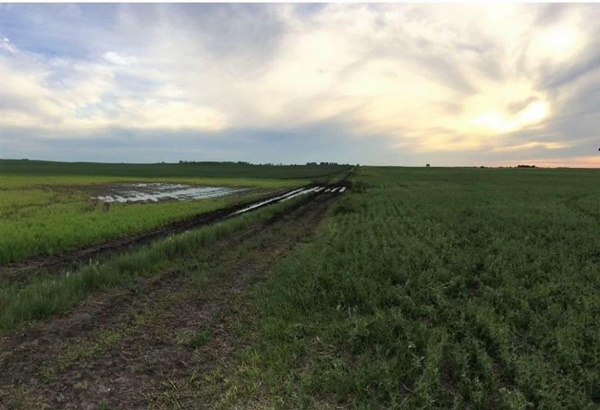
EVANSVILLE, Ind., Dec. 11 (UPI) — A growing number of America’s farmers are quietly preparing for a future in which rising global temperatures threaten their ability to grow food.
The most recent federal climate report confirmed what many farmers know firsthand — weather patterns are changing. And those changes could devastate food production.
“The planet will get warmer and warmer and warmer,” said Klaus Lackner, the director of the Center for Negative Carbon Emissions. “Food production will be more difficult, more expensive and in places it will fail.”
It’s already started.
The Great Plains, where farmers count on rainfall to produce many thousands of acres of grain, is experiencing more regular droughts. Midwestern fields, where generations of farmers have reliably grown corn, are flooding before harvest time. Land in the northern United States and Canada that was once too cold for corn and soy can now grow both.
These shifting weather patterns will become more severe in the coming decades, according to the U.S. Global Change Research Program’s most recent National Climate Assessment.
The report’s message to farmers: Adapt their methods to survive — and soon.
“It’s going to be management of extremes,” said Paul Overby, a North Dakota farmer. “It might be really dry one year and really wet the next. But we are going to have to grow either way.”
Overby was the first farmer in his area to answer the call to adapt. In the early 2000s, he made a series of changes in his farming methods that he hoped would make his land more resilient to future droughts.
The changes were fairly simple. He stopped tilling his fields after harvest, and instead immediately replanted them with what are known as “cover crops.” These winter plants, like rye or barley, secure the soil and keep important nutrients from being washed away by winter rain.
Though the changes are small, they represent a dramatic shift in standard American farming practices.
Most farmers in America till their fields after they harvest and before they plant. The bare dirt is sprayed with herbicides, pesticides and fertilizers to grow a large crop.
In the short-term, this approach produces high yields. But scientists say it leaves the soil vulnerable — and unhealthy.
The soil in America’s most fertile farming land is meant to have plants — like grass — growing in it year-round. Their roots keep nutrients in place, as well as all types of insects and microbial life.
“If you keep something on the ground so it’s not exposed to wind and rain and sun, then the life of the soil is more robust,” said Tom Driscoll, director of the National Farmers Union Foundation and Conservation Policy.
It’s also better able to handle severe weather. Those deep roots and microbes retain limited moisture during drought years and absorb excess moisture during floods, Driscoll said.
More than a decade after converting to no-till, Overby said the difference he sees is huge. His nutrient-dense soil needs substantially less fertilizer, and his fields are ready to plant almost regardless of weather.
“After a heavy rain, my neighbor’s fields all have standing water,” he said. “My fields act like a sponge and soak up the water. You can see the difference.”
He paused a moment.
“I don’t know why every farmer isn’t doing this,” he said.
Though more farmers are switching to sustainable models every year, they are still in the minority.
This is partly because the current agricultural market favors a select number of plants, called commodity crops, Driscoll said. These are plants like wheat, corn and soy. Farmers are encouraged to grow commodity crops by national policy. The Farm Bill gives preference to these plants by federally subsidizing their crop insurance programs.
This makes growing a commodity crop less risky. But because the market is so flush with these products, in order to make money at it, farmers must produce high yields, Driscoll said. They accomplish these high yields using the traditional model: Till the soil, spray pesticides and herbicides to knock out other life, and replace lost nutrients with fertilizers.
“That is why you see people blasting the ground with nitrate fertilizers,” Driscoll said.
It’s hard to predict how long this system will hold — but it’s not indefinite. The National Climate Survey predicts significant disruption will be common within the next century.
“We have a system now where people farm to yield,” Driscoll said. “It’s not manageable. It’s okay to get a lower yield if you don’t spend as much money to get it. But people don’t think that way. That has to change.”
Major farmer lobbying groups still support the traditional model, and they are hesitant to back policies that would change it — especially if those policies are aimed at combating climate change. There is great fear among farmers that such policies, especially policies that seek to limit greenhouse gas emissions on farms, will cost them dearly.
The American Farm Bureau has a list of climate change regulations it opposes. The bureau did not return UPI’s request for comment on this story.
“Farmers are worried about people telling them what they can and can’t grow,” Driscoll said. “They’re worried about regulations.”
That fear can make it difficult to persuade a farmer to prepare for climate change, said Tim Marema, a spokesman for the Center for Rural Strategies.
“The politicization of climate change has meant agricultural groups like the Farm Bureau have not dealt squarely with issues of climate change,” Marema said. “It gets talked about as severe weather. It’s an event in a place, as opposed to an ecological system that needs attention.”
Though mainstream groups are still hesitating, others are going around them, directly to the farmer. Programs that teach sustainability are appearing across the country. Some of these groups have a scientific background, others are led by other growers.
These groups tend to avoid the climate change topic altogether. Instead, they hyper-focus on something growers can’t deny — the changing weather in their area.
Farmers’ dependence on weather means they’ve seen it changing, Driscoll said.
“We have to look deep at what are the costs and benefits to the farmers,” said Josette Lewis, the executive vice president of ecosystems and sustainable agriculture at the Environmental Defense Fund. “We have millions of acres of farmland that is all individually managed. The degree that we make it evident it is in their best interest will help us make that shift over millions of acres.”
After years of using no-till and cover crops, Overby now teaches the practice to other farmers.
It took more than a decade, but there is finally another grower in his neighborhood who has switched to no-till.
“I think it has the potential to catch on,” Overby said. “I am focused on younger farmers. I’m 60, and I have neighbors who say that it all makes sense, but I’m going to keep farming the way I always have because I’m too old to change it now. So, I’m trying to get the younger farmers. They’re the ones who are really going to have to deal with this.”





